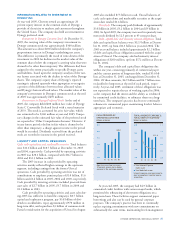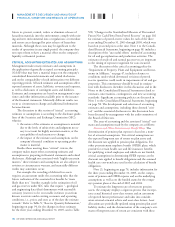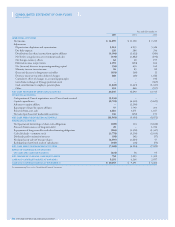Chevron 2005 Annual Report Download - page 49
Download and view the complete annual report
Please find page 49 of the 2005 Chevron annual report below. You can navigate through the pages in the report by either clicking on the pages listed below, or by using the keyword search tool below to find specific information within the annual report.CHEVRON CORPORATION 2005 ANNUAL REPORT 47
studies. The expected long-term rate of return on United
States pension plan assets, which account for 72 percent of
the company’s pension plan assets, has remained at 7.8 per-
cent since 2002.
The year-end market-related value of assets of the major
U.S. pension plan used in the determination of pension
expense was based on the market value in the preceding three
months as opposed to the maximum allowable period of fi ve
years under U.S. accounting rules. Management considers
the three-month period long enough to minimize the effects
of distortions from day-to-day market volatility and still be
contemporaneous to the end of the year. For other plans,
market value of assets as of the measurement date is used in
calculating the pension expense.
The discount rate assumptions used to determine U.S.
and international pension and postretirement benefi t plan obli-
gations and expense refl ect the prevailing rates available on
high-quality fi xed-income debt instruments. At December 31,
2005, the company selected a 5.5 percent discount rate based
on Moody’s Aa Corporate Bond Index and a cash fl ow
analysis using the Citigroup Pension Discount Curve for the
major U.S. pension and postretirement benefi t plans. The
discount rates at the end of 2004 and 2003 were 5.8 percent
and 6 percent, respectively.
An increase in the expected long-term return on plan
assets or the discount rate would reduce pension plan
expense, and vice versa. Total pension expense for 2005 was
approximately $600 million. As an indication of the sen-
sitivity of pension expense to the long-term rate of return
assumption, a 1 percent increase in the expected rate of
return on assets of the company’s primary U.S. pension plan,
which accounted for about 53 percent of the companywide
pension obligation, would have reduced total pension plan
expense for 2005 by approximately $50 million. A 1 percent
increase in the discount rate for this same plan would have
reduced total benefi t plan expense for 2005 by approximately
$130 million. The actual rates of return on plan assets and
discount rates may vary signifi cantly from estimates because
of unanticipated changes in the world’s fi nancial markets.
In 2005, the company’s pension plan contributions were
approximately $1 billion (nearly $800 million to the U.S.
plans). In 2006, the company expects contributions to be
approximately $500 million. Actual contribution amounts
are dependent upon plan-investment results, changes in
pension obligations, regulatory environments and other
economic factors. Additional funding may be required if
investment returns are insuffi cient to offset increases in plan
obligations.
Pension expense is recorded on the Consolidated State-
ment of Income in “Operating expenses” or “Selling, general
and administrative expenses” and applies to all business seg-
ments. Depending upon the funding status of the different
plans, either a long-term prepaid asset or a long-term liability
is recorded. Any unfunded accumulated benefi t obligation in
excess of recorded liabilities is recorded in “Other compre-
hensive income.” See Note 21 to the Consolidated Financial
Statements, beginning on page 74, for the pension-related
balance sheet effects at the end of 2005 and 2004.
For the company’s OPEB plans, expense for 2005 was
about $200 million and was also recorded as “Operating
expenses” or “Selling, general and administrative expenses”
in all business segments.
Effective January 1, 2005, the company amended its
main U.S. postretirement medical plan to limit future
increases in the company contribution. For current retirees,
the increase in company contribution is capped at 4 percent
each year. For future retirees, the 4 percent cap will be effec-
tive at retirement. For active employees and retirees below
age 65 whose claims experiences are combined for rating
purposes, the assumed health care cost trend rates start with
10 percent in 2006 and gradually drop to 5 percent for 2011
and beyond.
As an indication of discount rate sensitivity to the deter-
mination of OPEB expense in 2005, a 1 percent increase in
the discount rate for the company’s primary U.S. OPEB plan,
which accounted for about 80 percent of the companywide
OPEB obligation, would have decreased OPEB expense by
approximately $20 million.
Impairment of Property, Plant and Equipment and Invest-
ments in Affi liates The company assesses its property, plant
and equipment (PP&E) for possible impairment whenever
events or changes in circumstances indicate that the carrying
value of the assets may not be recoverable. Such indicators
include changes in the company’s business plans, changes in
commodity prices and, for crude oil and natural gas prop-
erties, signifi cant downward revisions of estimated proved
reserve quantities. If the carrying value of an asset exceeds
the future undiscounted cash fl ows expected from the asset,
an impairment charge is recorded for the excess of carrying
value of the asset over its fair value.
Determination as to whether and how much an asset is
impaired involves management estimates on highly uncertain
matters such as future commodity prices, the effects of infl a-
tion and technology improvements on operating expenses,
production profi les and the outlook for global or regional
market supply and demand conditions for crude oil, natural
gas, commodity chemicals and refi ned products. How-
ever, the impairment reviews and calculations are based on
assumptions that are consistent with the company’s business
plans and long-term investment decisions.
The amount and income statement classifi cation of
major impairments of PP&E for the three years ending
December 31, 2005, are included in the commentary on the
business segments elsewhere in this discussion. An estimate
as to the sensitivity to earnings for these periods if other
assumptions had been used in the impairment reviews and
impairment calculations is not practicable, given the broad
range of the company’s PP&E and the number of assump-
tions involved in the estimates. That is, favorable changes to
some assumptions might have avoided the need to impair any
assets in these periods, whereas unfavorable changes might
have caused an additional unknown number of other assets
to become impaired.
Investments in common stock of affi liates that are
accounted for under the equity method, as well as invest-
ments in other securities of these equity investees, are
























